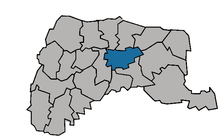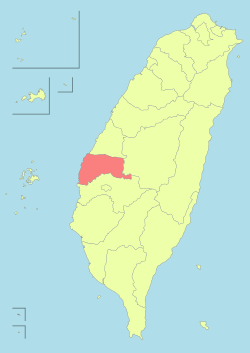Huwei, Yunlin
Coordinates: 23°43′12″N 120°26′07″E / 23.719983°N 120.435364°E


.jpg)
.jpg)
Huwei Township (Chinese: 虎尾鎮; pinyin: Hǔwěi Zhèn; Pe̍h-ōe-jī: Hó͘-bóe-tìn or Hó͘-bé-tìn) is an urban township in Yunlin County, Taiwan. It has a population of about 70,269.
Name
In the 17th century, during the Dutch era, Favorolang was one of the largest and most powerful aboriginal villages in Taiwan.[1] The name has also been spelled Favorlang, Favorlangh, and Vovorollang.[2] Its location was north of Tirosen (modern-day Chiayi), and the Favorlang river had been called by the Chinese How-boe-khe (Chinese: 吼尾溪) during the reign of the Qing Yongzheng Emperor (ca. 1722 – 1735). The Chinese name for the area (Chinese: 大崙腳庄) was later changed to Go-keng-chhu (Chinese: 五間厝庄; Pe̍h-ōe-jī: Gō͘ -keng-chhù-chng).[3][4]
The name Favorlang is said to have derived from the ethnonym Babuza,[5] a tribe of the Taiwanese Plains Aborigines.
In 1920, during Taiwan's Japanese era, the town was administered as Kobi Town (Japanese: 虎尾庄), under Kobi District (虎尾郡), Tainan Prefecture. During this era, the town earned the nickname of "Sugar Capital" (糖都).
Government
Administrative divisions
There are 29 villages:[6]
- Ancing
- Ansi
- Beisi
- Desing
- Dingsi
- Dongren
- Dongtun
- Fangcao
- Gong-an
- Hueilai
- Jhongshan
- Jhongsi
- Jianguo
- Jyuetou
- Kendi
- Lenei
- Lianshih
- Liren
- Pinghe
- Sanhe
- Si-an
- Siasi
- Singnan
- Singjhong
- Sinji
- Sinsing
- Situn
- Yanping
- Yingchuan
Local government
Economy
- Huwei Sugar Factory
Education
Tourist attractions
- Huwei Sugar Factory Iron Bridge
- SL Towel Industrial Tourism and Explore Factory
- Tongxin Park
- Yunlin Hand Puppet Museum
- Yunlin Story House
Transportation

The township houses the Taiwan High Speed Rail (THSR) Yunlin Station.
Famous residents
Sister city relations
-
 Ōma, Aomori Prefecture, Japan[8]
Ōma, Aomori Prefecture, Japan[8]
See also
| Wikimedia Commons has media related to Huwei Township, Yunlin County. |
References
- ↑ Andrade, Tonio (2005). "Chapter 7: The Challenges of a Chinese Frontier". How Taiwan Became Chinese: Dutch, Spanish, and Han Colonization in the Seventeenth Century. Columbia University Press.
- ↑ Campbell, William (1903). "Explanatory Notes". Formosa under the Dutch: described from contemporary records, with explanatory notes and a bibliography of the island. London: Kegan Paul. p. 542. OCLC 644323041.
- ↑ 楊彥騏 (2003). 虎尾的大代誌 (in Chinese). Yunlin: 雲林縣政府文化局. ISBN 9789570138382.
- ↑ "Entry #40044". 臺灣閩南語常用詞辭典 [Dictionary of Frequently-Used Taiwan Minnan] (in Chinese and Hokkien). Ministry of Education, R.O.C. 2011.
- ↑ Li, Paul Jen-kuei (2003). "Introduction: Notes on Favorlang, an Extinct Formosan language". In Ogawa, Naoyoshi. English-Favorlang vocabulary. Tokyo: Research Institute for Languages and Cultures of Asia and Africa. pp. 1–13. ISBN 4872978536.
- ↑ "Welcome To Huwei". Huwei Township Office. 2010.
- ↑ http://uld.judicial.gov.tw/indexen.asp
- ↑ "International Exchange". List of Affiliation Partners within Prefectures. Council of Local Authorities for International Relations (CLAIR). Retrieved 21 November 2015.
External links
- Huwei Township Office (English)
